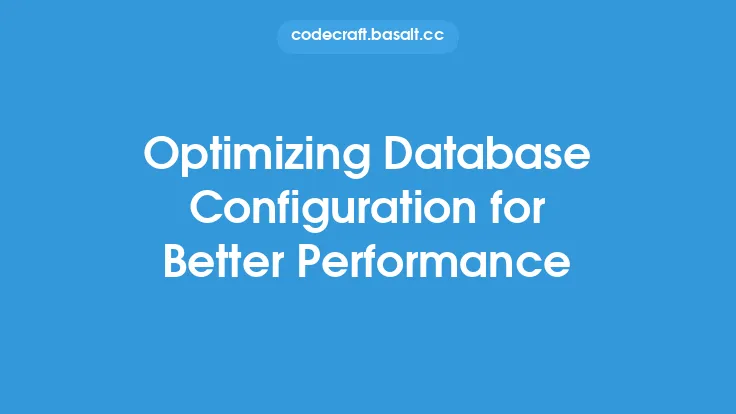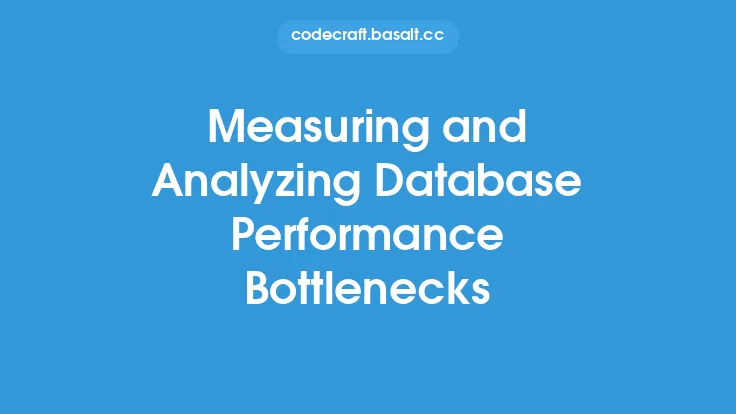Database performance tuning is a critical aspect of ensuring a seamless and efficient user experience. As databases continue to grow in size and complexity, optimizing their performance becomes increasingly important. A well-tuned database can significantly improve the overall performance of an application, leading to increased user satisfaction and reduced operational costs. In this article, we will delve into the world of database performance tuning, exploring the various techniques and strategies that can be employed to enhance user experience.
Introduction to Database Performance Tuning
Database performance tuning involves a series of steps and techniques aimed at optimizing the performance of a database. This can include optimizing database configuration, indexing, caching, and query optimization, among other things. The goal of database performance tuning is to ensure that the database can handle the required workload efficiently, providing fast and reliable access to data. A well-tuned database can improve the overall performance of an application, leading to increased user satisfaction and reduced operational costs.
Understanding Database Architecture
To effectively tune a database, it's essential to understand the underlying architecture. A typical database architecture consists of several components, including the database engine, storage subsystem, and network infrastructure. The database engine is responsible for managing data and executing queries, while the storage subsystem provides the physical storage for the data. The network infrastructure connects the database to the application and other components. Understanding how these components interact and impact performance is critical to effective database tuning.
Query Optimization Techniques
Query optimization is a critical aspect of database performance tuning. Queries that are poorly optimized can lead to significant performance degradation, resulting in slow response times and increased latency. Several techniques can be employed to optimize queries, including rewriting queries to reduce complexity, using indexes to improve data retrieval, and optimizing join operations. Additionally, techniques such as query caching and result caching can be used to reduce the load on the database and improve performance.
Indexing Strategies
Indexing is a powerful technique for improving database performance. An index is a data structure that allows the database to quickly locate and retrieve specific data. By creating indexes on frequently accessed columns, queries can be optimized to reduce the amount of data that needs to be scanned, resulting in significant performance improvements. However, indexing can also have a negative impact on performance if not implemented correctly. It's essential to carefully consider indexing strategies to ensure that they are aligned with the specific needs of the application.
Database Configuration Optimization
Database configuration plays a critical role in determining performance. Configuration parameters such as buffer pool size, sort area size, and log file size can significantly impact performance. Optimizing these parameters can help to improve performance by reducing the amount of time spent on disk I/O, sorting, and logging. Additionally, configuration parameters such as connection pooling and thread pooling can be optimized to improve concurrency and reduce contention.
Storage Subsystem Optimization
The storage subsystem is a critical component of the database architecture, and optimizing its performance can have a significant impact on overall database performance. Techniques such as disk striping, mirroring, and caching can be used to improve storage performance. Additionally, using high-performance storage devices such as solid-state drives (SSDs) can significantly improve performance. It's also essential to ensure that the storage subsystem is properly configured and maintained to prevent performance degradation.
Network Infrastructure Optimization
The network infrastructure is responsible for connecting the database to the application and other components. Optimizing network performance can help to reduce latency and improve overall database performance. Techniques such as using high-speed network interfaces, optimizing network protocols, and reducing network congestion can be used to improve network performance. Additionally, using techniques such as load balancing and connection pooling can help to improve concurrency and reduce contention.
Monitoring and Analyzing Performance
Monitoring and analyzing performance is a critical aspect of database performance tuning. By monitoring performance metrics such as response time, throughput, and latency, database administrators can identify performance bottlenecks and optimize the database accordingly. Several tools and techniques are available for monitoring and analyzing performance, including database management system (DBMS) built-in tools, third-party monitoring tools, and performance benchmarking tools.
Best Practices for Database Performance Tuning
Several best practices can be employed to ensure effective database performance tuning. These include regularly monitoring and analyzing performance, optimizing database configuration and indexing, and using query optimization techniques. Additionally, using techniques such as caching and connection pooling can help to improve performance. It's also essential to ensure that the database is properly maintained and updated to prevent performance degradation.
Conclusion
Database performance tuning is a critical aspect of ensuring a seamless and efficient user experience. By understanding database architecture, query optimization techniques, indexing strategies, and database configuration optimization, database administrators can optimize database performance and improve overall application performance. Additionally, monitoring and analyzing performance, optimizing storage and network infrastructure, and employing best practices can help to ensure effective database performance tuning. By following these techniques and strategies, organizations can improve user satisfaction, reduce operational costs, and gain a competitive advantage in the market.





